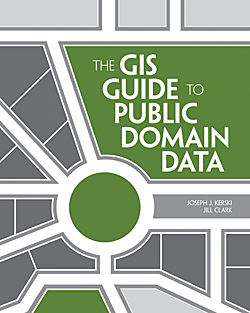ArcUser
Summer 2012 Edition
The GIS Guide to Public Domain Data
By Joseph J. Kerski and Jill Clark
This article as a PDF.
 Geospatial technology has evolved to answer specific questions, and much, if not most, of the data exists somewhere in the public domain. In an age characterized by exabytes (a billion billion billion bytes) of available data and Internet access to it, obtaining geospatial data shouldn't be a problem. However, as the authors of The GIS Guide to Public Domain Data observe, while it is easier to use geospatial data, it is also easier to misuse it.
Geospatial technology has evolved to answer specific questions, and much, if not most, of the data exists somewhere in the public domain. In an age characterized by exabytes (a billion billion billion bytes) of available data and Internet access to it, obtaining geospatial data shouldn't be a problem. However, as the authors of The GIS Guide to Public Domain Data observe, while it is easier to use geospatial data, it is also easier to misuse it.
Joseph J. Kerski and Jill Clark have written this text to help students, researchers, and GIS professionals locate and evaluate public domain data so they can use it more intelligently and responsibly.
The authors' goals are to make readers better understand the unique characteristics of spatial data, become more aware of the organizations and initiatives that produce spatial data as well as the associated history and issues, and develop greater proficiency in working with this data to solve real-world problems.
Just because data is accessible doesn't mean it is in the public domain. Even data that was initially released into the public domain can change status when compiled by a third party. Before examining various sources of public data, the authors clarify what is meant by public domain and the types of copyright licensing that determine how data can be used. The United States has a tradition of making the data collected by government agencies freely available, but that is not true everywhere. Consequently, while data may be in the public domain, it is sometimes not especially easy to access.
Beyond copyright and accessibility issues, questions about the appropriateness of the data for addressing the problem at hand must also be answered. The next five chapters discuss the strengths and limitations of data in terms of format and source. Understanding the characteristics of data formats allows their suitability and quality to be better assessed. Why an organization originally collected a dataset often determines characteristics such as accuracy, precision, and currency that are important when evaluating the suitability of a dataset for a specific use.
The authors note that free data is not really free, because labor costs are typically associated with processing the data before it can be used. Data preparation is a real cost. When this is taken into consideration, it can be more cost-effective to obtain data from a vendor.
The seventh chapter, on how to use public domain data in a project, looks at how to choose the right data and software tools, address any ethical concerns, and measure the success of a project.
The final three chapters consider the impact of new phenomena, such as data user as data provider and the rise of cloud computing, as well as the future of public domain data.
Many resources for additional information contained in articles, papers, and guidelines are highlighted throughout the text. Online exercises provide a reality check for readers. They experience the benefits and frustrations of working with public domain data to solve real-world problems. (The book assumes the reader has intermediate skills with ArcGIS for Desktop.)
This approach to understanding public domain data is both comprehensive and systematic. It presents a wealth of detailed information in one handy reference.
The book's authors both have backgrounds in GIS. Kerski, education manager for Esri, has been a geographer and cartographer at the National Oceanic and Atmospheric Administration, the US Census Bureau, and the US Geological Survey. He is past president of the National Council for Geographic Education. Clark, a freelance consultant and technical author, has worked in many areas of GIS, including application development and implementation, software development, service provision, and technical writing. Esri Press, 2012, 350 pp., ISBN: 978-1589482449